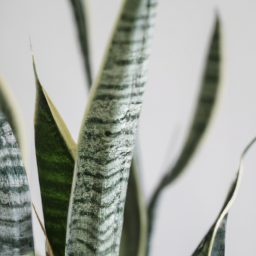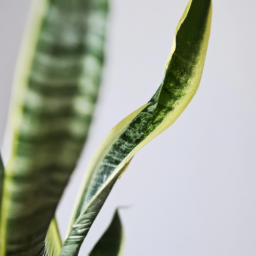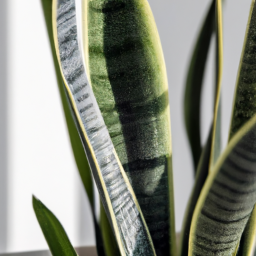
If you’re looking to add some greenery to your indoor space, snake plant varieties are a fantastic option to consider. These unique plants come in a variety of shapes, sizes, and colors, making them a versatile choice for any home or office. Whether you’re a seasoned plant parent or just starting out, there’s a snake plant variety out there that’s perfect for you. In this blog post, we’ll explore some of the most popular snake plant varieties and provide tips on how to care for them so you can enjoy their beauty for years to come. So sit back, relax, and let’s dive into the wonderful world of snake plants!
Popular Snake Plant Varieties for Indoor Gardening
Welcome to our guide on popular snake plant varieties for indoor gardening! If you’re looking to add some greenery to your home or office, snake plants are a great choice. Not only are they easy to care for, but they also come in a wide range of varieties, each with its own unique characteristics. In this article, we’ll explore some of the most popular snake plant varieties and provide tips on how to care for them.
Sansevieria Trifasciata (Mother-in-Law’s Tongue)
One of the most common snake plant varieties, Sansevieria Trifasciata, also known as Mother-in-Law’s Tongue, is a popular choice for indoor gardening. This variety features long, upright leaves with green and yellow striping, giving it a striking appearance. Mother-in-Law’s Tongue is a low-maintenance plant that thrives in a variety of lighting conditions, making it perfect for beginners.
When caring for Sansevieria Trifasciata, it’s important to avoid overwatering as this can lead to root rot. Water your plant sparingly, allowing the soil to dry out between waterings. Mother-in-Law’s Tongue prefers bright, indirect light, but can also tolerate low light conditions. Keep your plant away from drafts and cold temperatures to ensure it stays healthy and vibrant.
To propagate Sansevieria Trifasciata, simply divide the plant at the root and repot the sections in fresh soil. This variety is known for its air-purifying properties, making it a great addition to any indoor space.
Sansevieria Cylindrica (African Spear)
Another popular snake plant variety is Sansevieria Cylindrica, also known as African Spear. This variety features cylindrical, upright leaves that give it a unique and modern look. African Spear is a hardy plant that can thrive in a variety of conditions, making it a versatile choice for indoor gardening.
When caring for Sansevieria Cylindrica, it’s important to provide it with well-draining soil to prevent root rot. Water your plant sparingly, allowing the soil to dry out between waterings. African Spear prefers bright, indirect light, but can also tolerate low light conditions. Keep your plant away from cold drafts to prevent damage to the leaves.
To propagate Sansevieria Cylindrica, simply cut a leaf into sections and plant them in fresh soil. This variety is known for its air-purifying properties and can help improve indoor air quality.
Sansevieria Moonshine
Sansevieria Moonshine is a popular snake plant variety known for its silvery-green leaves that have a subtle shimmer in the light. This variety is a great choice for adding a touch of elegance to any indoor space. Sansevieria Moonshine is a low-maintenance plant that thrives in a variety of lighting conditions, making it ideal for beginners.
When caring for Sansevieria Moonshine, it’s important to avoid overwatering as this can lead to root rot. Water your plant sparingly, allowing the soil to dry out between waterings. Moonshine prefers bright, indirect light, but can also tolerate low light conditions. Keep your plant away from cold drafts and extreme temperatures to ensure it stays healthy and vibrant.
To propagate Sansevieria Moonshine, simply divide the plant at the root and repot the sections in fresh soil. This variety is known for its air-purifying properties and can help improve indoor air quality.

How to Care for Different Snake Plant Varieties
Choosing the Right Snake Plant Variety
When it comes to caring for snake plants, it’s important to choose the right variety for your specific needs and environment. There are several different types of snake plants, each with its own unique characteristics and care requirements. Some popular varieties include the Sansevieria trifasciata, Sansevieria cylindrica, and Sansevieria moonshine.
The Sansevieria trifasciata, also known as the mother-in-law’s tongue, is one of the most common snake plant varieties. It has long, sword-shaped leaves that are green with yellow edges. This variety is relatively low-maintenance and can thrive in a variety of light conditions, from low light to bright, indirect light.
Sansevieria cylindrica, on the other hand, has cylindrical, spear-like leaves that grow upright. This variety is more compact than the Sansevieria trifasciata and is well-suited for small spaces. It prefers bright, indirect light and requires less frequent watering compared to other snake plant varieties.
The Sansevieria moonshine is a newer variety that features silvery-green leaves with a subtle shimmer. This variety is more sensitive to overwatering and requires well-draining soil to prevent root rot. It thrives in bright, indirect light and should be watered sparingly, allowing the soil to dry out between waterings.
Caring for Your Snake Plant Variety
Once you’ve selected the right snake plant variety for your space, it’s important to provide the proper care to ensure its health and longevity. Here are some general care tips for different snake plant varieties:
1. Light: Most snake plant varieties prefer bright, indirect light but can also tolerate low light conditions. Avoid placing your snake plant in direct sunlight, as this can cause the leaves to burn. Rotate your plant occasionally to ensure even growth.
2. Watering: Snake plants are drought-tolerant and should be watered sparingly. Allow the soil to dry out completely between waterings to prevent root rot. In general, it’s better to underwater than overwater your snake plant, as they are more likely to survive dry conditions than soggy soil.
3. Soil: Use a well-draining potting mix for your snake plant to prevent waterlogged soil. A mix of potting soil, perlite, and sand works well for most snake plant varieties. Repot your snake plant every 2-3 years to refresh the soil and provide room for growth.
4. Temperature and Humidity: Snake plants prefer temperatures between 60-85°F (15-29°C) and can tolerate a wide range of humidity levels. Avoid placing your plant near drafts or heaters, as sudden temperature changes can stress the plant.
5. Fertilizing: Snake plants are not heavy feeders and can thrive without regular fertilization. If you choose to fertilize your snake plant, use a balanced, water-soluble fertilizer diluted to half strength every 2-4 weeks during the growing season.
Troubleshooting Common Issues
Despite their reputation as low-maintenance plants, snake plants can still experience issues if not properly cared for. Here are some common problems and solutions for different snake plant varieties:
1. Yellowing leaves: Yellow leaves can be a sign of overwatering or inadequate light. Check the soil moisture level and adjust your watering schedule accordingly. Move your plant to a brighter location if it’s not receiving enough light.
2. Drooping leaves: Drooping leaves can indicate underwatering or root rot. Check the soil moisture and adjust your watering frequency as needed. If root rot is present, repot your plant in fresh soil and trim any affected roots.
3. Pests: Snake plants are relatively pest-resistant, but they can occasionally attract spider mites, mealybugs, or aphids. Inspect your plant regularly for signs of pests and treat infestations with insecticidal soap or neem oil.
By following these care tips and troubleshooting common issues, you can ensure that your snake plant variety thrives in your home or office space. Remember to observe your plant regularly and adjust your care routine as needed to keep it healthy and happy.

Exploring Unique Snake Plant Varieties for Your Home Décor
Introduction
When it comes to adding greenery to your home, snake plants are a popular choice due to their low maintenance and air purifying qualities. However, there are many different varieties of snake plants to choose from, each with its own unique characteristics. In this guide, we will explore some of the most unique snake plant varieties that you can incorporate into your home décor.
Varieties of Snake Plants
Snake plants, also known as Sansevieria, come in a wide range of shapes, sizes, and colors. One of the most popular varieties is the Sansevieria trifasciata, also known as the mother-in-law’s tongue. This variety features long, sword-shaped leaves with green and yellow stripes, making it a striking addition to any room. Another popular variety is the Sansevieria cylindrica, which has cylindrical leaves that grow upright, giving it a more modern and architectural look.
If you’re looking for something a bit more unique, consider the Sansevieria boncellensis. This variety has thick, wavy leaves that resemble a coral reef, adding a touch of whimsy to your home décor. For a more compact option, the Sansevieria hahnii is a great choice. This variety has shorter, wider leaves that form a rosette shape, making it perfect for smaller spaces.
For those who want to add a pop of color to their home, the Sansevieria ballyi is a great choice. This variety has bright green leaves with dark green spots, giving it a playful and vibrant look. If you prefer a more subtle color palette, the Sansevieria ehrenbergii ‘Samurai Dwarf’ is a great option. This variety has short, stubby leaves with a silvery-green hue, adding a touch of elegance to any room.
Caring for Your Snake Plants
Regardless of which variety you choose, snake plants are relatively easy to care for. They thrive in indirect sunlight and should be watered sparingly, allowing the soil to dry out between waterings. Snake plants are also resilient to pests and diseases, making them a great choice for beginner plant owners.
To keep your snake plants looking their best, be sure to dust the leaves regularly and trim off any dead or yellowing leaves. You can also repot your snake plant every few years to refresh the soil and give it room to grow. With proper care, your snake plants will continue to thrive and add a touch of greenery to your home décor.
In conclusion, snake plants are a versatile and low-maintenance option for adding greenery to your home. With so many unique varieties to choose from, you can easily find one that complements your personal style and home décor. Whether you prefer a bold and colorful look or a more subtle and elegant aesthetic, there is a snake plant variety that is perfect for you. So go ahead and explore the world of snake plants to find the perfect addition to your indoor garden.
Key Takeaways
Snake plants, also known as Sansevieria, are popular houseplants due to their low maintenance and air-purifying qualities. There are several different varieties of snake plants, each with its own unique characteristics. The most common variety is the Sansevieria trifasciata, also known as the mother-in-law’s tongue, which has long, pointed leaves with yellow edges.
Another popular variety is the Sansevieria cylindrica, or cylindrical snake plant, which has round, cylindrical leaves that grow upright. The Sansevieria boncel, or dwarf snake plant, is a smaller variety with shorter, wider leaves. These plants come in a range of sizes and colors, making them versatile additions to any indoor space. Whether you prefer a tall, striking plant or a compact, colorful one, there is a snake plant variety to suit your taste and space requirements. With their hardy nature and striking appearance, snake plants are a great choice for both beginner and experienced plant enthusiasts alike.
FAQ Roundup:
Q1. What are some popular snake plant varieties?
A1. Some popular snake plant varieties include the Sansevieria trifasciata (also known as the Mother-in-Law’s Tongue), Sansevieria cylindrica (Cylindrical Snake Plant), and Sansevieria boncel (Boncel Snake Plant).
Q2. Are there any rare snake plant varieties?
A2. Yes, there are rare snake plant varieties such as the Sansevieria patens (Starfish Snake Plant), Sansevieria masoniana (Whale Fin Snake Plant), and Sansevieria kirkii (Cylindrical Snake Plant).
Q3. What are the differences between the different snake plant varieties?
A3. The differences between snake plant varieties can include differences in leaf shape, color, size, and pattern. Some varieties may have thicker leaves, while others may have more narrow or cylindrical leaves.
Q4. Which snake plant varieties are best for beginners?
A4. Beginner-friendly snake plant varieties include the Sansevieria trifasciata (Mother-in-Law’s Tongue) and Sansevieria cylindrica (Cylindrical Snake Plant) as they are easy to care for and can thrive in various light conditions.
Q5. Where can I find different snake plant varieties for purchase?
A5. You can find a variety of snake plant varieties for purchase at local plant nurseries, online plant shops, and even some home improvement stores. Make sure to check the availability of specific varieties before making a purchase.
Dr. Olivia Green is a botanist with over two decades of experience in indoor plant cultivation. She holds a Ph.D. in Plant Biology and has dedicated her career to researching plant behavior in controlled environments. Dr. Green is passionate about helping plant enthusiasts master the art of indoor gardening through her extensive knowledge and practical insights.


